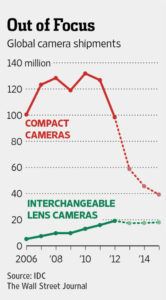The selfie: Canon’s biggest woe

Canon's attempt to remain relevant in the age of smartphones
Image 1: Ellen’s Oscar selfie
Photos, photos everywhere
Recognize the picture? Ellen DeGeneres live tweeted this famous Oscar 2014 selfie. Favorited over 7,00,000 times and retweeted more than 1.7 million times, Twitter temporarily crashed with the enormous traffic the photo attracted1. The photo wasn’t taken on a Canon or Sony camera but with the Samsung Galaxy Note 3!
Photos and Smartphones: Inseparable
Stars aren’t the only ones who like selfies. We all do! We use smartphones to click photographs, preferring the ‘all-in-one’ device to a separate camera. One may argue that the quality of a photo from a camera is superior. Although true earlier, frequent upgrades in smartphone cameras have significantly improved image quality. The images below taken from iPhones 1–6 show an improvement in quality with each upgrade. The iPhone 6s has a superior 12-megapixel camera, backside illumination sensor and several features which contribute to high quality images3. This short video4 compares the quality of videos taken on an iPhone 6s and Canon’s DSLR.
Image 2: Comparison of images taken from iPhones 1-6
Smartphones offer more features than cameras and both are available at multiple price points. More than convenience and low cost, the biggest advantage is being connected to the internet. With connectivity, photos and videos can be shared quickly, easily and in real time. The result: a staggering 1.8 billion photos are shared across social media networks such as Facebook, Snapchat etc every day! This ability has become a ‘sticky’ point for customers. As Christopher Chute, Director of worldwide digital imaging at IDC, a market intelligence firm, rightly points out “Image quality is now second to connectivity to web services like Facebook5”
Impact on camera companies
With users switching to phone cameras, the camera industry has seen an erosion in their value proposition. The graphs below illustrate the decline in camera sales over the years. Compact cameras, suffered the heaviest decline, reaching a peak in 2010 and reducing thereafter to ~40 million units in 20156. Even high-end cameras with interchangeable-lens (ILC’s) used by professional photographers, a category thought to be protected against the threat of smartphones, witnessed a 9.1% year-on-year decline in global shipment in 20136.
Canon, the Japanese camera maker and a global market leader, has been severely affected too. In 2013, Canon VP Toshizo Tanaka’s public statement, “The changes in the business environment are very severe.7”, summed up the enormity of the challenges ahead. The company’s stock price has lost more than half its value since 2007 and has repeatedly missed earnings targets in recent years8.
Image 3 & 4: Decline in sales and shipment of cameras
Canon’s response
In the short term, Canon slashed prices, especially on compact cameras. The decline in this segment was inevitable as customers were price sensitive and saw more value in smartphones, priced similarly.
Instead, Canon decided to cater to professional photographers, the higher end of the market. The company leveraged its strength of selling high quality cameras, something they felt smartphones could not provide.
In 2015, Canon launched over eight new models. All promised high quality photos and videos with the important upgrade, being wi-fi connectivity. This meant one could click photos, connect to their smartphone and share them across social media instantly. The price of $430 though, seemed high. This could keep customers away, given the wide price range of smartphones9.
With these efforts, Canon has retained dominant market share in 2015 in the high-end segments; ~55% in the DSLR and ~21% in the ILC segment10,11.
Other potential measures
Canon could have started a separate B2B business unit and partnered with phone manufacturers like Apple and Samsung to supply camera components such as sensors etc. Catering to their desire of continuous improvements in the phone camera, this could have been a win-win partnership. Canon could have leveraged its core competency of making high quality cameras and changed its operating model to adapt to new circumstances. Sony is doing this by expanding its profitable image sensor business with increased demand from customers like Apple and Xiaomi. As the saying goes, “When there’s a gold rush, sell shovels!12”
Targeting professional photographers with new launches and including wi-fi connectivity is certainly innovative. The company should also invest in R&D to develop radically new products. Sleeker, lighter and trendier cameras may appeal to younger and price sensitive customers, who have switched to smartphone cameras. Similarly, R&D can help Canon reduce prices to attract lost customers.
The Socialmatic or Instagram camera (image below) is one such example. Designed by ADR Studio, it is meant for Instagram fans. The camera has wi-fi connectivity, sufficient storage space, can be used to upload photos to Instagram from the device itself and can print polaroid pictures13. It is trendy and reasonably priced, starting at ~ $100.
Image 5: The Instagram or Socialmatic Camera
The challenge of competing with smartphones is immense but frequent and radical innovation is a way for Canon to remain relevant in these changing times.
(791 words)
Bibliography
1Fahy, Colette. “The epic selfie that broke twitter.” DailyMail.com, March 2, 2014. [http://www.dailymail.co.uk/tvshowbiz/article-2571848/Ellen-DeGeneres-wins-A-List-Oscars-crowd-gentle-teasing-Liza-Minnelli-not-impressed-mistaken-male-impersonator.html], accessed November 2016.
2Edwards, Jim. “Planet Selfie: We’re now posting a staggering 1.8 billion photos every day.” Business Insider, May 28, 2014. [http://www.businessinsider.com/were-now-posting-a-staggering-18-billion-photos-to-social-media-every-day-2014-5], accessed November 2016.
3Apple. “iPhone.” http://www.apple.com/iphone/compare/, accessed November 2016.
4PhoneArena. “Apple iPhone 6s vs DSLR camera: video comparison (4K vs 1080p).” YouTube, published October 16, 2015. [https://www.youtube.com/watch?v=kWNIwOzInQU], accessed November 2016.
5Ewoldt, John. “Smartphones are changing the picture for camera sales.” Journal Sentinel, December 22, 2013. [http://archive.jsonline.com/business/smartphones-are-changing-the-picture-for-camera-sales-b99167684z1-236955581.html], accesses November 2016.
6Osawa, Juro. “Phones Imperil Fancy Cameras.” Wall Street Journal, November 7, 2013. [http://www.wsj.com/articles/SB10001424052702304672404579183643696236868], accessed November 2016.
7Crothers, Brook. “Canon hit by rising popularity of smartphone cameras.” Cnet.com, July 25, 2013. [https://www.cnet.com/news/canon-hit-by-rising-popularity-of-smartphone-cameras/], accessed November 2016.
8Source: Stock price of Canon, via Nasdaq, accessed November 2016. http://www.nasdaq.com/symbol/caj/interactive-chart
9Dent, Steve. “Canon’s newest connected cameras: when a smartphone still won’t do.” Engadget.com, January 5, 2015. [https://www.engadget.com/2015/01/05/canons-newest-connected-cameras-when-a-smartphone-still-wont/], accessed November 2016.
10Samuels, Liron. “Japan has spoken: Canon dominates, Sony dethrones Olympus and Nikon stutter.” Diyphotography.net, February 21, 2015. [http://www.diyphotography.net/japan-has-spoken-canon-dominates-sony-dethrones-olympus-and-nikon-stutters/], accessed November 2016.
11Canon. “News.” http://global.canon/en/news/2016/20160329.html, accessed November 2016.
12Arthur, Charles. “Camera-makers focus on adapting to smartphones’ market surge.” The Guardian, April 13, 2015. [https://www.theguardian.com/technology/2015/apr/13/cameras-slrs-dslr-overtaken-by-smartphones-charles-arthur], accessed November 2016.
13Savvides, Lexy. “Socialmatic camera for Instagram runs Android.” Cnet.com, September 9, 2012. [https://www.cnet.com/news/socialmatic-camera-for-instagram-fans-runs-android/], accessed November 2016.
Images
- https://twitter.com/theellenshow/status/440322224407314432
- http://snapsnapsnap.photos/iphone-6s-camera-comparison/
- http://www.phonearena.com/news/Camera-vs.-Smartphone-Infographic-shares-the-impact-our-smartphones-have-had-on-regular-cameras_id53524
- http://www.wsj.com/articles/SB10001424052702304672404579183643696236868
- https://www.cnet.com/how-to/quickly-access-your-iphones-camera-roll-in-instagram-2-5/








Smartphone cameras have become so prevalent that I am shocked compact cameras still exist. I think Canon was right in focusing on professional photographers and the higher end of the market. While smartphone camera technology is impressive, there are limits to the quality and customization of a photo due to the size limits of a smartphone. Higher end cameras are able to produce high quality photos due to the size of the lens, aperature, etc – aspects that will not be able to perform as well (or at all) if given size constraints. That being said, I do feel like the value of a photo has shifted from one of quality, to one of being at the right place and capturing the right moment — something smartphone cameras are much better suited for.
While I agree with Canon’s current shift to focusing on professional photographers, I question whether Canon should launch a sub-brand to experiment with technologies for smartphone photographers. There are hundreds of free or low-cost smartphone apps for post-processing of images; this demonstrates that smartphone users value image quality. However, even the best app can’t correct for photos which are blurry or shot in extremely poor lighting conditions. Smartphone accessories offer consumers a low-cost way to improve image quality and experiment with more advanced photography techniques. For example, Canon could sell smartphone accessories such as add-on lenses, external flash, wireless remotes, and mounts for time-lapse photos. A fraction of the smartphone photographers may trade up to entry-level DSLR cameras after exposure to the improved quality and flexibility offered by such accessories.
Interesting post! While I agree with Canon’s move to focus on the professional photographer as its target consumer, I do believe that with the fast advancement in technology, even that space is not safe from future mobile takeover. If Canon wants to ensure that it doesn’t become the modern day Polaroid, it needs to ensure continuous innovation. It would benefit from partnering with mobile companies, or VR headset companies, or even a company such as google glass, to ensure the sustainability of the brand – because as mentioned in the comments above, quality of the picture only comes second in priority to convenience/ability to capture rare moments in today’s social media obsessed world.
One of Canon’s strength is its high quality optical lenses, so I agree that they should focus on partnership with smartphone companies such as Samsung or Apple. With its long history and reputation, I’m sure customers will be more than excited to buy an iPhone with “Canon camera inside”. Pursuing cheaper and trendier camera for young population might not be consistent with professional and high end image of Canon. Perhaps they can have a sub-brand to try out this strategy? This will certainly require lots of investment of Canon to develop this new capability. Thanks for sharing this!
In the last years we also have seen a massive interest for high quality, small and convenient video camero such as GoPro or Drift. Canon has also been integrating high quality and widely recognised video camera features in their latest camera. Do you think it could benefit from creating a new product line entirely focused on video that would compete with GoPro? It could leverage its wi-fi system to integrate it in the camera and make the end product readily available to be watched on a smartphone.
Great post! In the millennial landscape, I feel that it’s only people who are really interested into photography who buy cameras. The semi-professional ones are pretty bulky pieces of kit that are sometimes a bit of a nuisance to carry around. While creating sleeker wifi connected cameras seems like a good idea, I think they are running in a loosing race by competing against the likes of Apple and Samsung because everyone takes their phones everywhere and carrying another piece of equipment is – most of the time – impractical (says someone who always has an extra bag to carry around for a DSLR). I totally agree, however, that there is more potential in accessories / maybe collaborations on the lenses side of things.
Really interesting article. It definitely seems like high-end cameras such as the ones that Canon produces are less and less likely to attract mass audiences and targeting professional photographers is the right, maybe only, move. Have you considered their move of focusing more on video vs. still cameras? That move could target the film industry and might position them better in the long-run.
Interesting post! I like your idea of starting a separate B2B business to partner with phone manufacturers. In hindsight, this would’ve been an excellent move for these companies to remain relevant to the casual photographer. Nonetheless, now is the time for these camera companies to innovate and I think the company is on the right path with the social camera. The Canon brand still holds a strong reputation which the company can leverage to experiment while also pursuing more conservative moves like collaborating with phone manufacturers on lenses and add-on accessories.